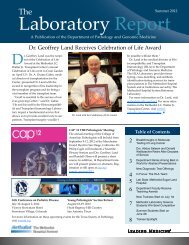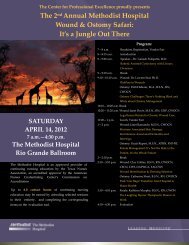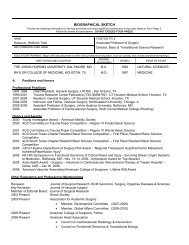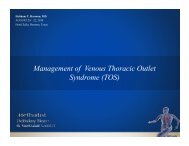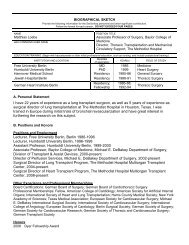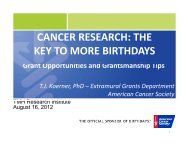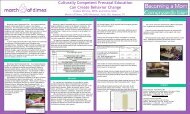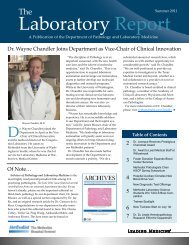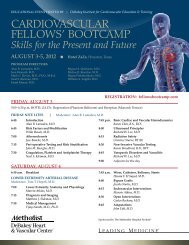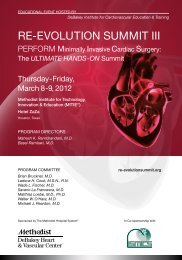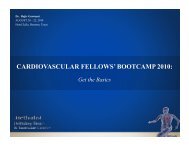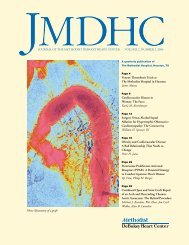DeBAKEy CARDIOvASCuLAR JOuRNAL - Methodist Hospital
DeBAKEy CARDIOvASCuLAR JOuRNAL - Methodist Hospital
DeBAKEy CARDIOvASCuLAR JOuRNAL - Methodist Hospital
Create successful ePaper yourself
Turn your PDF publications into a flip-book with our unique Google optimized e-Paper software.
My yEARS WITH MICHAEL E. <strong>DeBAKEy</strong><br />
Louis H. Green, M.D.<br />
In 1949, Dr. Michael E. DeBakey was 39 years old<br />
and I was 26. I had served a year in a rotating internship<br />
and another in a surgical residency at George<br />
Washington university Medical School, but my wife<br />
and I decided that we no longer wished to live in the<br />
East. We wanted to return to Texas, and meeting a<br />
young Michael DeBakey was impact enough.<br />
I was one of his residents, and Dr. DeBakey<br />
demanded that we be accurate, knowledgeable, and<br />
well read; he expected us to know all there was to know<br />
about the particular patient at hand. When working,<br />
there was little to no small talk, although in a social<br />
setting he could be very engaging. He was more than<br />
kind and made me his first appointee to the recently<br />
acquired vA <strong>Hospital</strong> in Houston.<br />
I remember the great procedure that initiated what<br />
became a medical wildfire. During the last week of<br />
December 1952, Dr. DeBakey called Jeff Davis to set up<br />
an emergency operation on a well-known candidate.<br />
This man had been used as a demonstration patient<br />
with a palpable abdominal aortic aneurysm. The procedure<br />
of aortic resection with replacement homograft<br />
was carried out by the team of Drs. DeBakey and<br />
Cooley with assistance from the senior resident and me,<br />
the junior resident. The homograft had been prepared<br />
by the process of lyophilization, which was a freezedrying<br />
method for having a graft in reserve, and with<br />
the addition of saline to be prepared for grafting.<br />
a triBute to MiCHael e. de Bakey, M.d.<br />
The patient had a stormy post-operative course, survived,<br />
and within two weeks had a thoracic aneurysm<br />
resection with homograft replacement at The <strong>Methodist</strong><br />
<strong>Hospital</strong>. Post-operative care was assiduous, demanding<br />
meticulous attention and care. Eventually, out of necessity,<br />
it lead to the development of the Intensive Care<br />
unit, which was ultimately adopted all over the country.<br />
Things were never the same. Celebrities came from<br />
all over the world as the Texas Medical Center was the<br />
only place to receive this type of surgery. All roads did<br />
lead to Houston — at least for the next 30 to 40 years.<br />
The rest is history.<br />
In the ensuing years, Dr. DeBakey was always<br />
supportive of me. When I came to him with a medical<br />
problem, I was berated for not bringing it to him<br />
sooner. He was always quiet about this support, but I<br />
knew that it was always there.<br />
During my later years in private practice, I realized<br />
what a fine and thorough training I had under<br />
Dr. DeBakey. He had insisted that the resident do the<br />
surgery and that the assisting staff serve as assisting<br />
supervisor. He also felt strongly that producing a<br />
skilled surgeon required more than observation and<br />
assisting: the resident surgeon must bear full responsibility.<br />
Dr. DeBakey will be remembered always in this<br />
personal way, and at the same time I will never forget<br />
his contribution to the advancement of medicine and<br />
surgery.<br />
MDCvJ | vII (1) 2011 63



